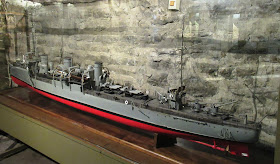During its short existence between the First and Second World Wars and since the collapse of the Soviet Union, the primary mission of the Estonian Navy has always been to protect her coastline from foreign threats.
Destroyer Wambola
The Wambola was originally the Soviet destroyer Spartak. She was captured on 26th December 1918 by ships of the Royal Navy (by cruisers HMS Caradoc and HMS Calypso, and the destroyers HMS Vendetta, HMS Vortigern, and HMS Wakeful. She was handed over to the Estonian government in January 1919 and commissioned into the Estonian Navy in December 1919. She was subsequently sold to the Peruvian Navy in 1933.
Patrol Vessel Pikker (1939)
Pikker was built in 1939 to serve as both a patrol vessel and as the Presidential yacht. She was incorporated into the Soviet Navy after the takeover in 1940, and became a command ship, keeping her original name. She was subsequently renamed Kiev (1941), Luga (1942), and then Ilmen. She was then transferred to the Black Sea, and in 1948 she became a dispatch vessel and was renamed Rioni. In 1961 she was renamed yet again and became the survey vessel Moskovskiy Universitet. Ship was finally removed from service in 1978.
Border Guard Patrol Boat Pikker (1995)
Built in 1996, the Pikker serves as a patrol boat with the Estonian Border Guard.
Like the rest of the Baltic States, Estonia has used ferries to maintain regular passenger and vehicle communications with its neighbours.
Ferry Kuivastu
Ferry Georg Ots
Ferry Estonia
Estonia (which had previously been named Viking Sally (1980 to 1990), Silja Star (1990 to 1991), and Wasa King (1991 to 1993)), operated as a cruise ferry between Tallinn and Stockholm. At 1.15am on Wednesday, 28th September 1994, whilst sailing through rough weather on her way towards Stockholm, the bow doors failed after repeatedly being hit by large waves. The ship immediately began to list to starboard, and within fifteen minutes she was laying on her starboard side as water flooded in and began to fill her vehicle deck. Just after 1.20am the general alarm was sounded and a 'Mayday' call was made on the ship's radio.
Because of the list many passengers were trapped and unable to abandon ship. As a result only 138 of the 989 people on board were able to escape before Estonia sank at approximately 1.50am. One of those rescued subsequently died, bringing the death toll to 852, making this the second worst European peacetime maritime disaster (the first was the sinking of the Titanic in 1912) and the worst peacetime maritime disaster to have occurred in European waters.
Destroyer Wambola
The Wambola was originally the Soviet destroyer Spartak. She was captured on 26th December 1918 by ships of the Royal Navy (by cruisers HMS Caradoc and HMS Calypso, and the destroyers HMS Vendetta, HMS Vortigern, and HMS Wakeful. She was handed over to the Estonian government in January 1919 and commissioned into the Estonian Navy in December 1919. She was subsequently sold to the Peruvian Navy in 1933.
Patrol Vessel Pikker (1939)
Pikker was built in 1939 to serve as both a patrol vessel and as the Presidential yacht. She was incorporated into the Soviet Navy after the takeover in 1940, and became a command ship, keeping her original name. She was subsequently renamed Kiev (1941), Luga (1942), and then Ilmen. She was then transferred to the Black Sea, and in 1948 she became a dispatch vessel and was renamed Rioni. In 1961 she was renamed yet again and became the survey vessel Moskovskiy Universitet. Ship was finally removed from service in 1978.
Border Guard Patrol Boat Pikker (1995)
Built in 1996, the Pikker serves as a patrol boat with the Estonian Border Guard.
Like the rest of the Baltic States, Estonia has used ferries to maintain regular passenger and vehicle communications with its neighbours.
Ferry Kuivastu
Ferry Georg Ots
Ferry Estonia
Estonia (which had previously been named Viking Sally (1980 to 1990), Silja Star (1990 to 1991), and Wasa King (1991 to 1993)), operated as a cruise ferry between Tallinn and Stockholm. At 1.15am on Wednesday, 28th September 1994, whilst sailing through rough weather on her way towards Stockholm, the bow doors failed after repeatedly being hit by large waves. The ship immediately began to list to starboard, and within fifteen minutes she was laying on her starboard side as water flooded in and began to fill her vehicle deck. Just after 1.20am the general alarm was sounded and a 'Mayday' call was made on the ship's radio.
Because of the list many passengers were trapped and unable to abandon ship. As a result only 138 of the 989 people on board were able to escape before Estonia sank at approximately 1.50am. One of those rescued subsequently died, bringing the death toll to 852, making this the second worst European peacetime maritime disaster (the first was the sinking of the Titanic in 1912) and the worst peacetime maritime disaster to have occurred in European waters.












No comments:
Post a Comment
Thank you for leaving a comment. Please note that any comments that are spam or contain phishing messages or that come from Google Accounts that are 'Unknown' will be deleted.